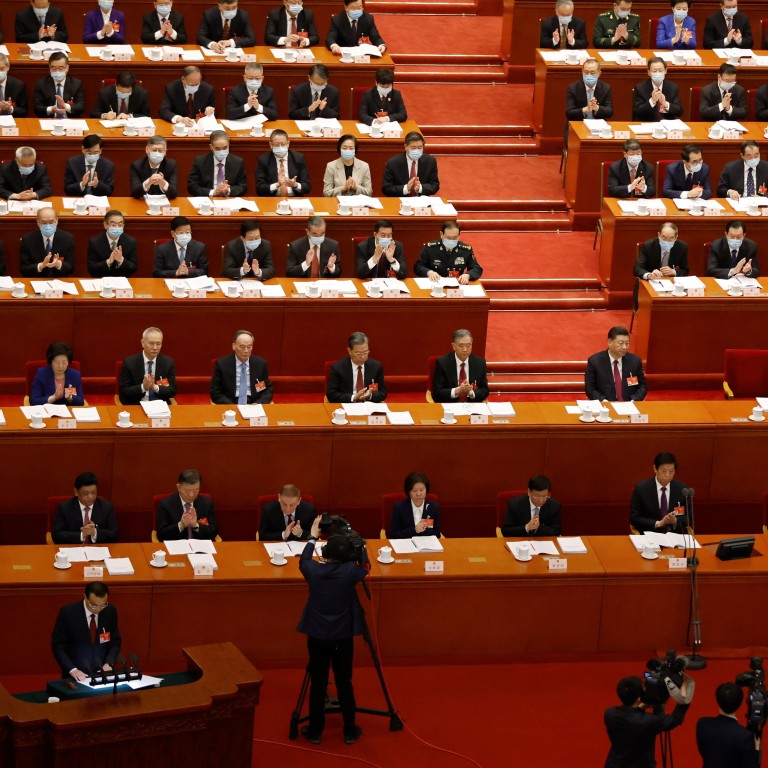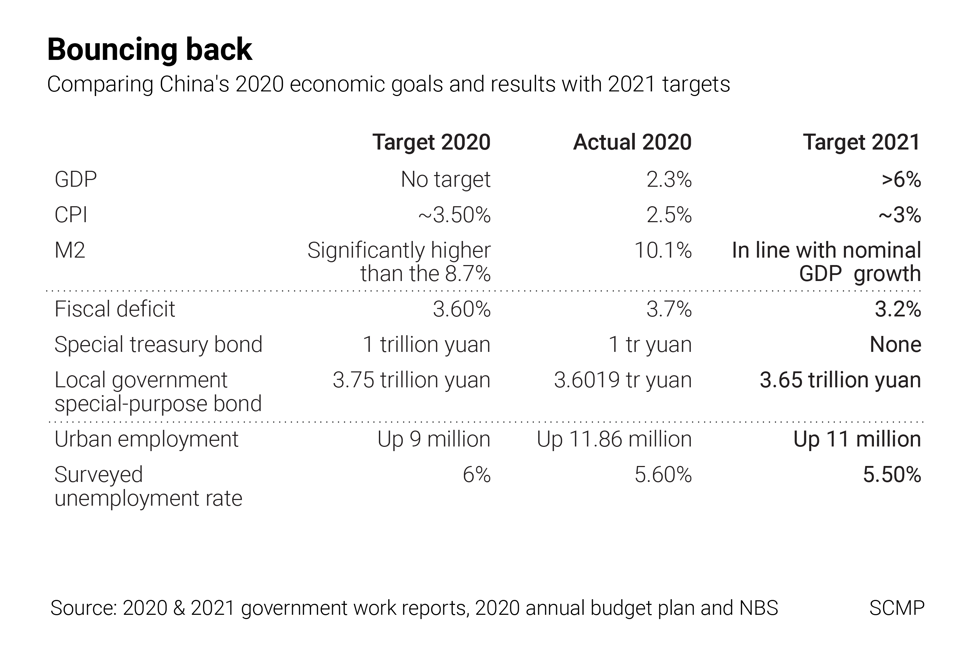
China GDP: economic growth target of ‘above 6 per cent’ for 2021 confirmed by Premier Li Keqiang
- China set an economic growth target of ‘above 6 per cent’ for 2021, Premier Li Keqiang confirmed at the National People’s Congress (NPC) on Friday in Beijing
- China has set a target of creating 11 million new urban jobs, while the target for consumer price index (CPI) growth is around 3 per cent
China set an economic growth target of “above 6 per cent” for 2021 as the country continues its strong rebound from the impact of the coronavirus pandemic last year, Premier Li Keqiang announced Friday at the National People’s Congress in Beijing.
As expected, Beijing reined in its fiscal stimulus for this year. It reduced the central government’s budget deficit-to-gross domestic product target to “around 3.2 per cent” from 3.6 per cent in 2020.

In 2020, China created 11.86 million new urban jobs, 131.8 per cent of the target.
It also set the local government special bond issuance quota at 3.65 trillion yuan (US$564 billion), down from 3.75 trillion yuan last year. Li confirmed that “no Covid-19 bonds will be issued” after China issued 1 trillion yuan of special Treasury bonds last year.
A target of over 6 per cent will enable all of us to devote full energy to promoting reform, innovation, and high-quality development. The projected targets for growth, employment, and CPI should keep the economy performing within the appropriate range
“A target of over 6 per cent will enable all of us to devote full energy to promoting reform, innovation, and high-quality development. The projected targets for growth, employment, and CPI should keep the economy performing within the appropriate range,” Li added.
“These targets are also well-aligned with the annual goals of subsequent years in the 14th Five-Year Plan period, and they will help sustain healthy economic growth.”
After it was not included in the government work report last year, Li also confirmed a grain output target of over 650 million tonnes for 2021.
He also said China would also “keep the [yuan] exchange rate generally stable at an adaptive, balanced level” this year.
“We will give even greater priority to serving the real economy, and balance the needs of promoting economic recovery and preventing risks. We will see that increases in money supply and aggregate financing are generally in step with economic growth in nominal terms, maintain a proper and adequate level of liquidity supply, and keep the macro leverage ratio generally stable,” he said.
Amid concerns about its population, Li said China would “work to achieve an appropriate birth rate” and that the “statutory retirement age will be raised in a phased manner” as part of the 14th Five-Year Plan covering 2021-25.
Beijing did not provide annual population and birth figures for 2020 when it released a series of economic indicators in January.
English language version of China’s government work report
The figure is not China’s official birth rate for 2020 as the hukou system does not include the entire population, but added to the concerns over the outlook for China’s population.
For more than four decades, China’s retirement age has remained unchanged at 60 for men and 55 for women, although it can be earlier for women in blue-collar jobs.
But amid the growing concern about a demographic crisis, the current gap has been blamed for stoking gender inequality and wasting human resources.
We will make all-round efforts to build a Healthy China. We will develop a strong public health system, carry out extensive public fitness activities, and raise the average life expectancy by one year
“We will make all-round efforts to build a healthy China. We will develop a strong public health system, carry out extensive public fitness activities, and raise the average life expectancy by one year,” Li said. Life expectancy in China currently 77.3 years.
“We will implement the national strategy for addressing population ageing, and improve the population services system with a focus on elderly care and child care. We will work to achieve an appropriate birth rate.
“The statutory retirement age will be raised in a phased manner. The multi-tiered social security system will be improved, with coverage of basic old-age insurance reaching 95 per cent of the population. Social assistance and charity systems will also be improved.”

.JPG?itok=J8tgfPmW&v=1659948715)